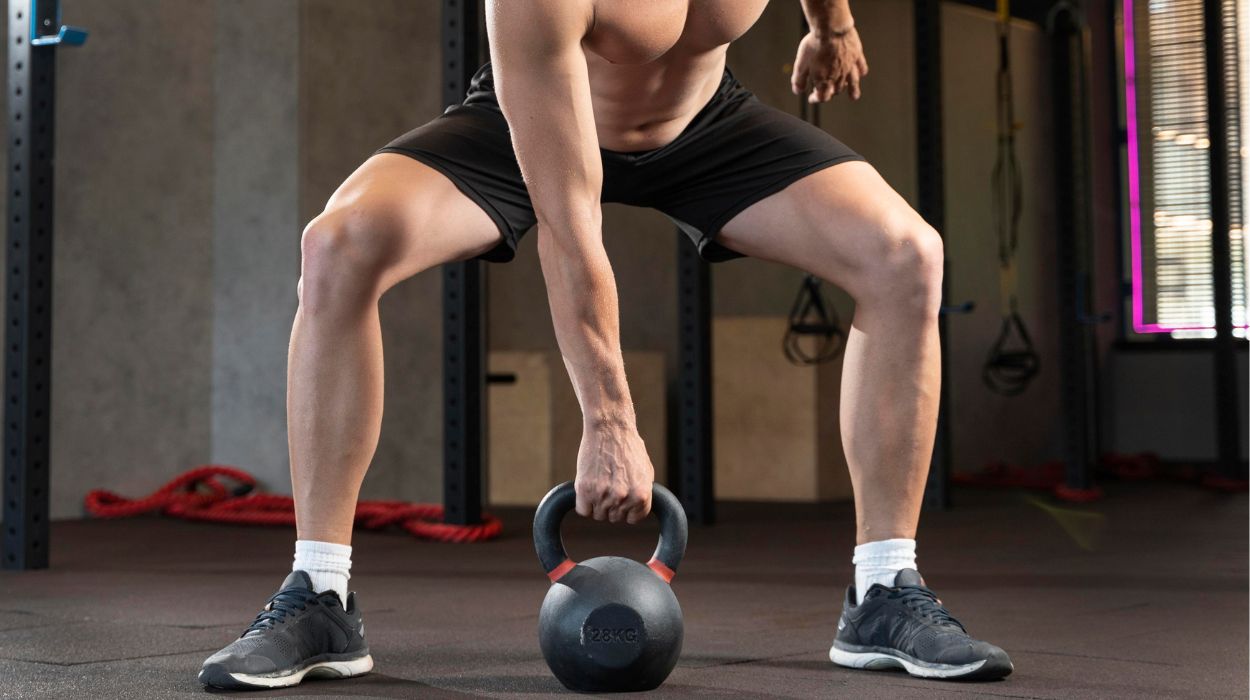
For some time, the kettlebell exercise regime has been a steadfast tool used in workouts. It can be effective in helping you unlock your core strength, enhance your physique, and level up your workout routine. A kettlebell ab workout can be your ultimate game-changer in the quest for a well-toned midsection. Combining strength training with aerobic elements pushes your body to its limit, stimulating your muscles[1] and keeping your core muscles tight like no other.
For those looking for a versatile routine that can be performed anywhere, a standing kettlebell ab workout is an excellent choice, requiring minimal space yet offering substantial results. When these exercises are paired with a balanced healthy diet and a potent fat burner, they morph into an even more effective weight loss strategy. This dynamic combination[2] can help you torch calories, trim your waistline, and bring you one step closer to achieving your fitness aspirations.
Best Kettlebell Ab Exercises Of All Time
Here are ten effective kettlebell exercises for stronger abs:
Kettlebell Ab Workout For Stronger Muscles
Looking to strengthen your core muscles? Dive into our guide on the Best Kettlebell Ab Workout for a rock-solid midsection. We’ll explore effective exercises to boost your core strength and help you achieve your fitness goals.
Kettlebell Russian Twist
This exercise engages your obliques and improves rotational strength as you twist the kettlebell from side to side. Perfect for those looking to sculpt their midsection and enhance core stability.
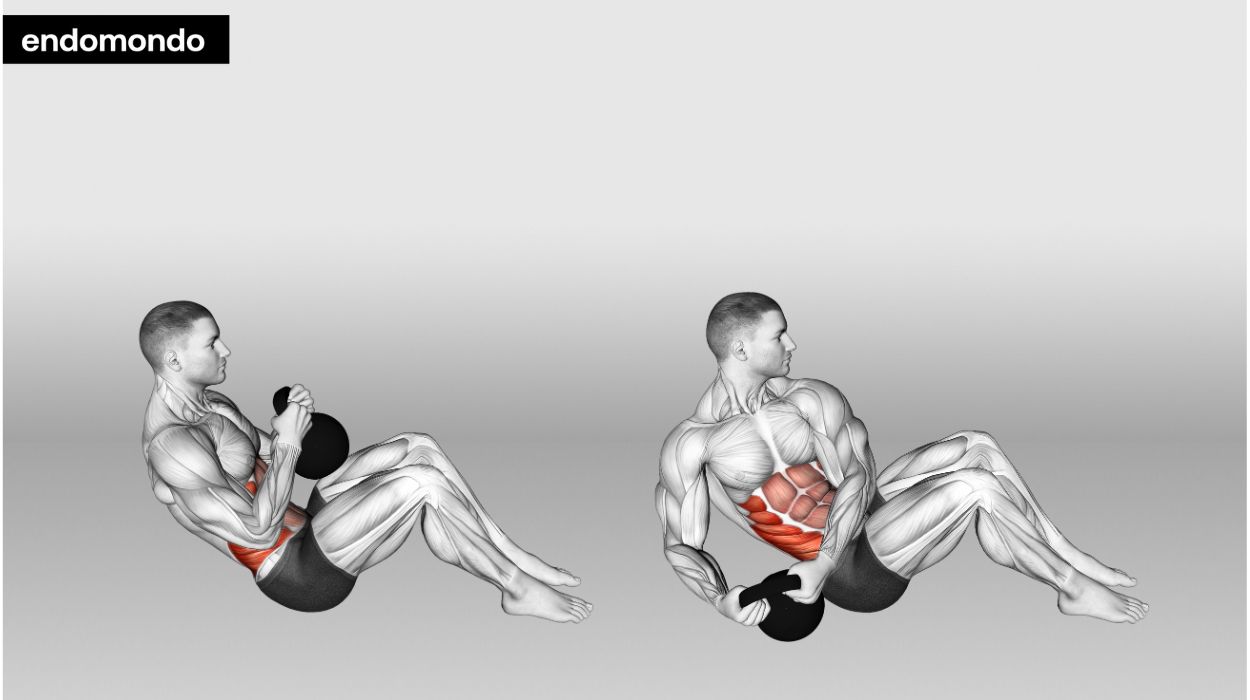
How to do:
- Start by sitting on the ground with your legs bent and heels resting on the floor.
- Hold a lighter kettlebell (about five pounds) at your chest, and lean back slightly.
- Twist your torso to the left, then to the right, moving the kettlebell across your body and tapping momentarily on the ground for ten reps on each side.
Tips:
- Sit with a straight back and engaged core to protect your spine.
- Rotate your torso from side to side while keeping your hips stable.
- Use a controlled motion and tap the kettlebell on the floor beside your hip on each side.
Optimal Sets and Reps: 3 sets of 12-15 reps per side.
Kettlebell Windmill
Elevate your strength and flexibility with the Kettlebell Windmill. By gracefully bending at the waist while holding a kettlebell overhead, you’ll target your core and improve mobility in the hips and shoulders.
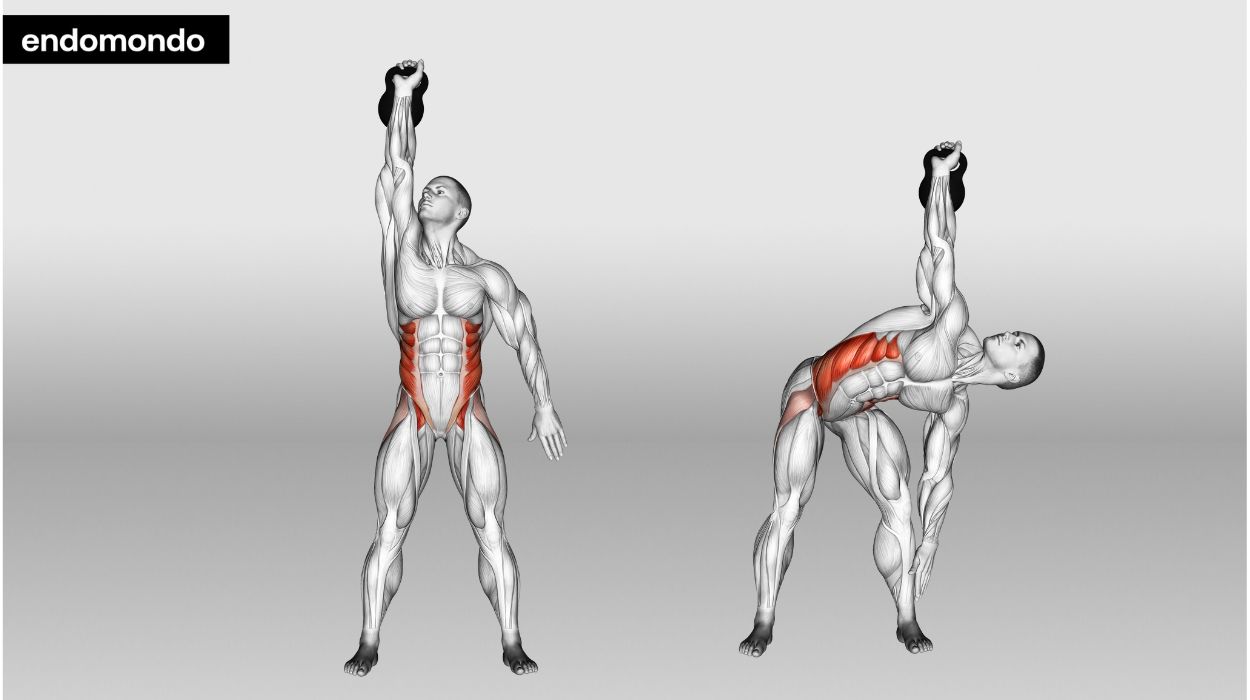
How to do:
- Stand straight, holding a kettlebell in your right hand, arms extended overhead.
- Bend your hips to the left and reach for your left foot, keeping your left arm straight and extended overhead. Your arms may look like a windmill.
- Return to the starting position while maintaining a straight spine and stabilizing the weight at chest level. Breathe out as you exert force and in as you relax.
- Repeat with the opposite sides.
Tips:
- Keep your feet shoulder-width apart and your core engaged for stability.
- Maintain a straight arm overhead as you hinge at the hips and lower the kettlebell.
- Focus on a smooth, controlled motion, and keep your gaze on the kettlebell for proper alignment.
Optimal Sets and Reps: 3 sets of 8-10 reps per side.
Kettlebell Swing
It is a powerful full-body exercise that hones in on strength, explosiveness, and cardiovascular fitness. By using a dynamic hip hinge motion, you’ll activate your glutes, hamstrings, and core, making it an ideal choice for improving power and endurance.
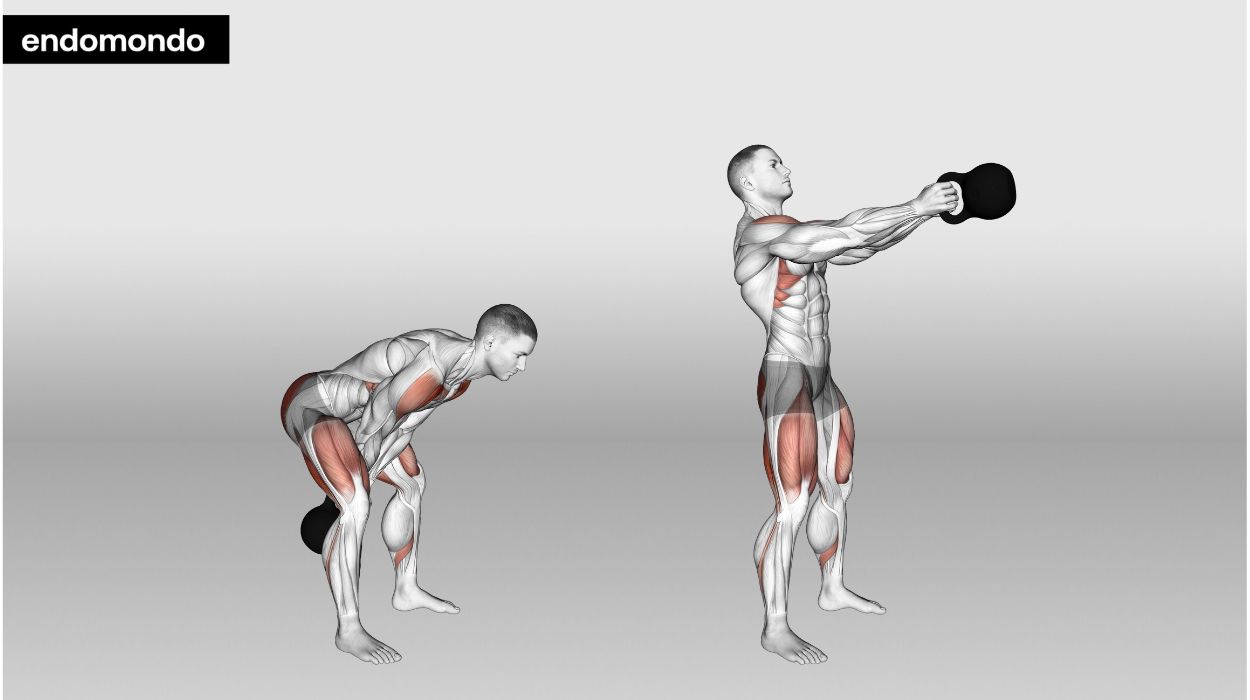
How to do:
- Stand with feet hip-width apart, holding a kettlebell in front of you with both hands.
- Bend your knees, swing the kettlebell back between your legs, and then push your hips forward as you swing it up to chest height. Be sure to keep your arms straight the entire time.
- Repeat the kettlebell swings ten times for a set.
Tips:
- Hinge at the hips and maintain a straight back to avoid straining your lower back.
- Power the swing from your hips and engage your glutes and core for maximum impact.
- Maintain a smooth, fluid motion, swinging the kettlebell between your legs, not above shoulder height.
Optimal Sets and Reps: 4 sets of 10-15 reps.
Kettlebell Around The World
This dynamic movement adds an enjoyable twist to your midsection training routine, making it a delightful challenge for your fitness journey.
How to do:
- Stand with your feet shoulder-width apart, holding a moderately heavy kettlebell in one hand.
- Pass the kettlebell around your waist to the other hand, then continue passing it around in a circle in kettlebell swings.
Tips:
- Maintain a firm grip on the kettlebell, and use controlled movements to trace a circular path around your body.
- Keep your core engaged to stabilize your torso and prevent excessive swaying.
- Perform the exercise in both clockwise and counterclockwise directions for balanced muscle engagement.
Optimal Sets and Reps: 3 sets of 10-12 reps in each direction (clockwise and counterclockwise).
Kettlebell Plank Drag
Take your plank to the next level with the Kettlebell Plank Drag. By dragging the kettlebell from side to side while maintaining a strong plank position, you’ll intensify your core engagement and enhance overall stability.
How to do:
- Begin in a high plank position, with elbows flat on the ground and with the kettlebell outside your left hand.
- Reach under your torso with your right hand, and drag the kettlebell to your right side.
- Pause briefly when the kettlebell is directly below the right shoulder and behind the right hand.
- Repeat on the other side.
Tips:
- Maintain a strong plank position with your core engaged to stabilize your body.
- Use a controlled motion to drag the kettlebell from one side to the other, minimizing any twisting or swaying.
- Keep your hips and shoulders square to the ground to avoid unnecessary strain on your lower back.
Optimal Sets and Reps: 3 sets of 8-10 reps per side.
Kettlebell Sit-Up
Take your ab routine to new heights with the Kettlebell Sit-Up. This exercise introduces an added challenge by incorporating a kettlebell. It’s a dynamic twist on a timeless exercise that’s sure to elevate your core strength.
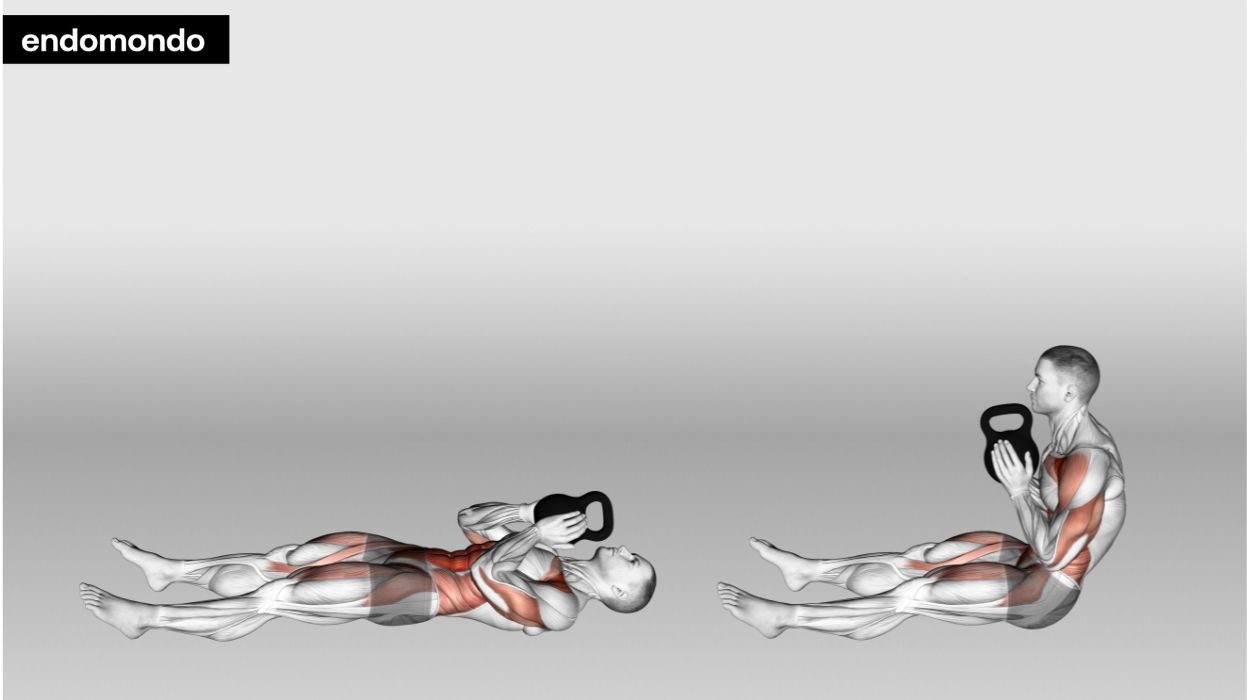
How to do:
- Lay flat on your back with your legs bent and a kettlebell on your chest.
- Perform a sit-up by tightening your core, keeping the kettlebell close to your body, and inhaling as you sit up.
- Slowly exhale as you return to the starting position.
Tips:
- Secure your feet under a stable surface or have a partner hold them for stability.
- Keep your back straight and avoid rounding it during the sit-up to prevent strain.
- Maintain a steady pace and focus on the quality of each repetition, prioritizing proper form over speed.
Optimal Sets and Reps: 3 sets of 12-15 reps.
Kettlebell Leg Raise
Strengthen your lower abdominal muscles with the Kettlebell Leg Raise. By incorporating the kettlebell, you’ll add resistance to your leg raises, challenging your core and enhancing overall stability.
How to do:
- Lay flat on your back, holding the kettlebell overhead.
- Lift your legs to a 90-degree angle while inhaling.
- Then lower them back down without touching the ground while exhaling.
Tips:
- Focus on maintaining stability by keeping your lower back pressed against the floor throughout the movement.
- Engage your core and use a slow, controlled motion to lift your legs toward the ceiling.
- Lower your legs back down without letting the kettlebell touch the ground for added challenge.
Optimal Sets and Reps: 3 sets of 12-15 reps.
Kettlebell Side Bend
Sculpt your obliques and improve lateral strength with the Kettlebell Side Bend. This exercise helps engage your core and target the side muscles of your torso.
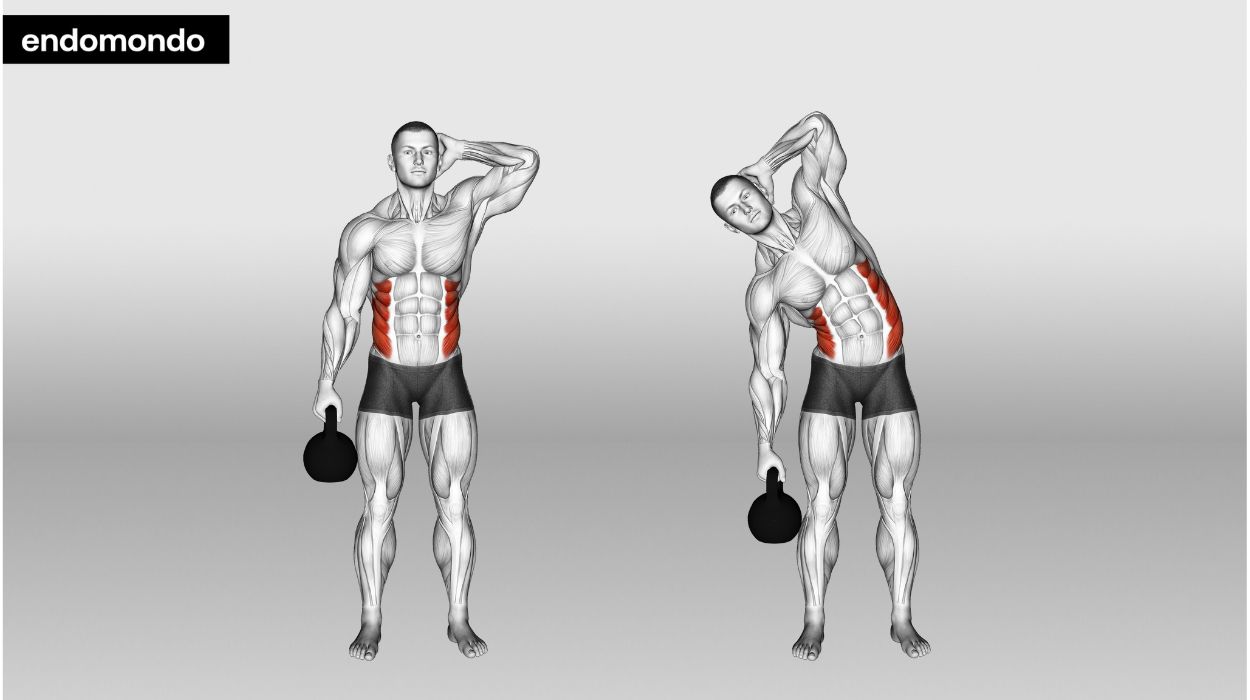
How to do:
- Start by holding a kettlebell in your left hand, and placing your hand on your right ear.
- Keeping your knees bent, bend your waist to the left, then return to the starting position.
- Repeat on the other side.
Tips:
- Hold the kettlebell in one hand and keep your core engaged to maintain stability.
- Bend sideways at the waist, focusing on the lateral flexion of your oblique muscles.
- Perform the exercise in a slow, controlled manner, avoiding any jerking or sudden movements.
Optimal Sets and Reps: 3 sets of 10-12 reps per side.
Kettlebell Dead Bug
This engaging movement not only strengthens your core muscles but also enhances coordination, functional strength, and posture.
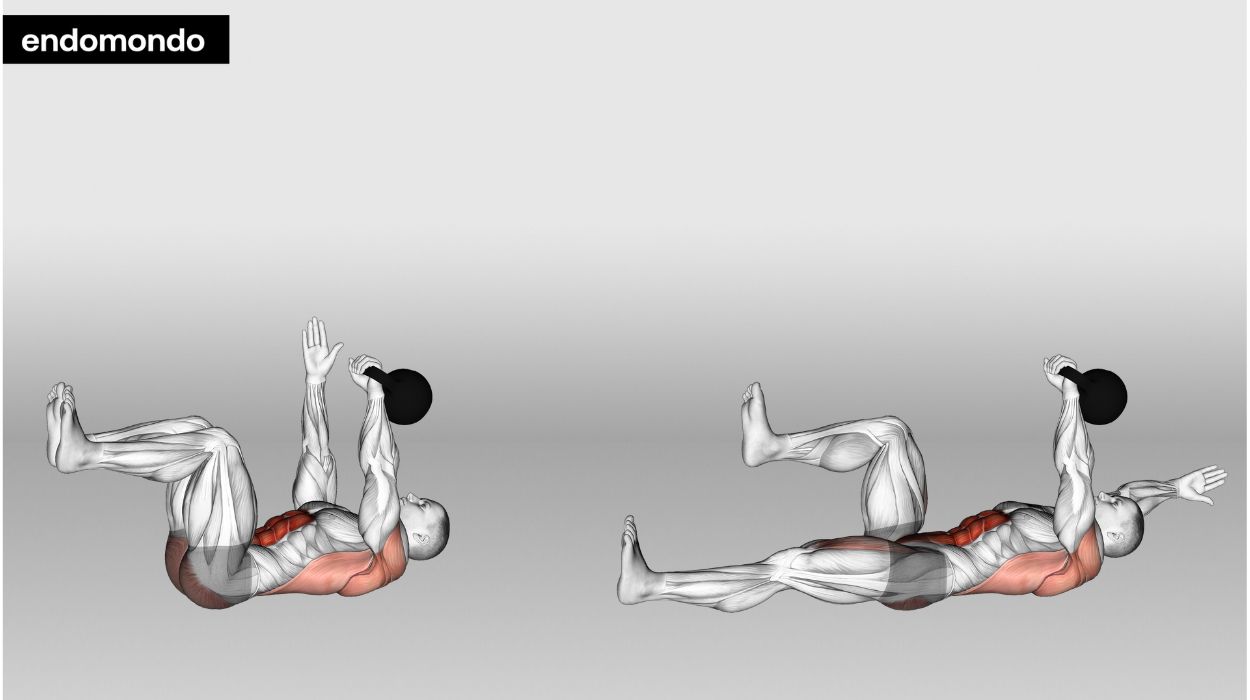
How to do:
- Lay on your back with a kettlebell in your left hand, left knee bent.
- Extend your right arm and right leg as you exhale, then bring them back in with a deep breath.
- Repeat on the other side.
Tips:
- Maintain a neutral spine by focusing on pressing your lower back into the ground.
- Keep your extended arm and leg close to the ground without actually touching it.
- Sync your breathing with the movement for better control.
Optimal Sets and Reps: 3 sets of 6-8 reps.
Kettlebell Half Get-Up
Boost your functional strength and mobility with the Kettlebell Half Get-Up. It’s a versatile movement that promotes full-body fitness.
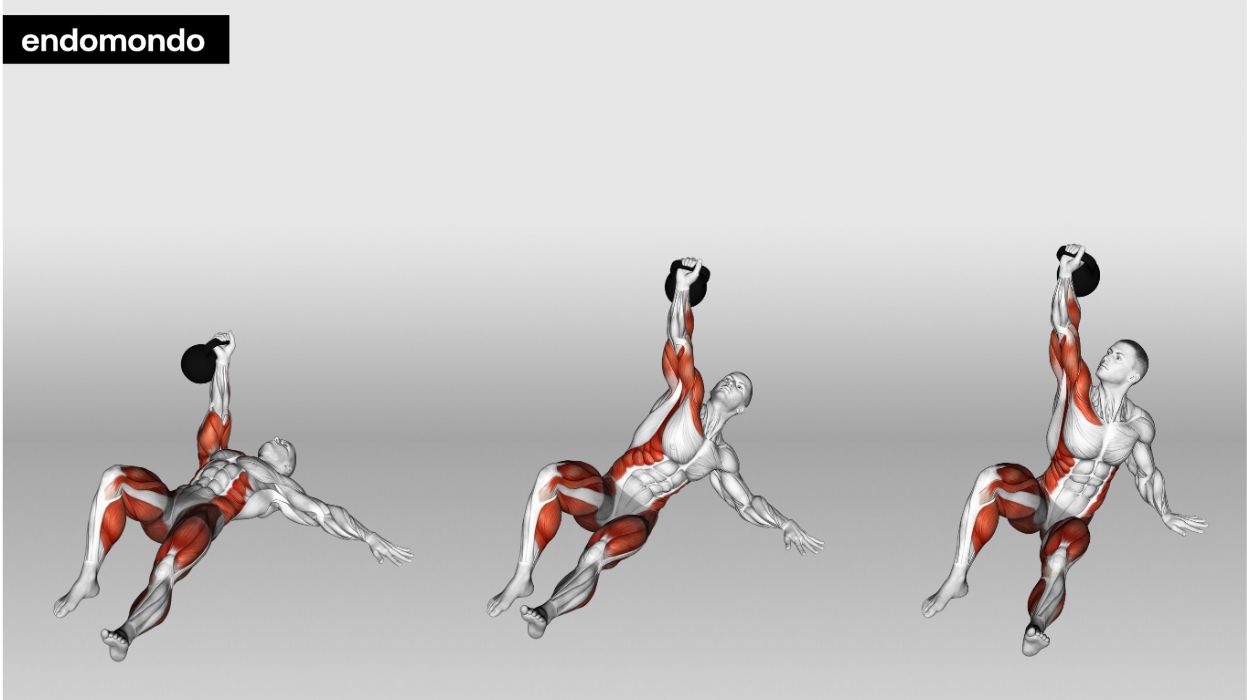
How to do:
- Lay on your back, holding a kettlebell in your right hand, with your right knee bent and foot planted on the floor. Your left leg should remain extended out.
- Place your right hand on the floor and use it for assistance as you tighten your abs and lift your torso off the ground, keeping the kettlebell overhead at all times as you inhale deeply. You should now be sitting up.
- Exhale as you slowly return your back to the floor at the starting position. Switch legs and arms and repeat the movement on each side.
Tips:
- Start with a stable grip on the kettlebell and keep your eyes on it throughout the movement.
- Maintain a straight wrist and engage your core as you rise from the ground.
- Control the descent back to the starting position to maximize the exercise’s benefits.
Optimal Sets and Reps: 3 sets of 8-10 reps per side.
Benefits Of The Kettlebell Ab Workout
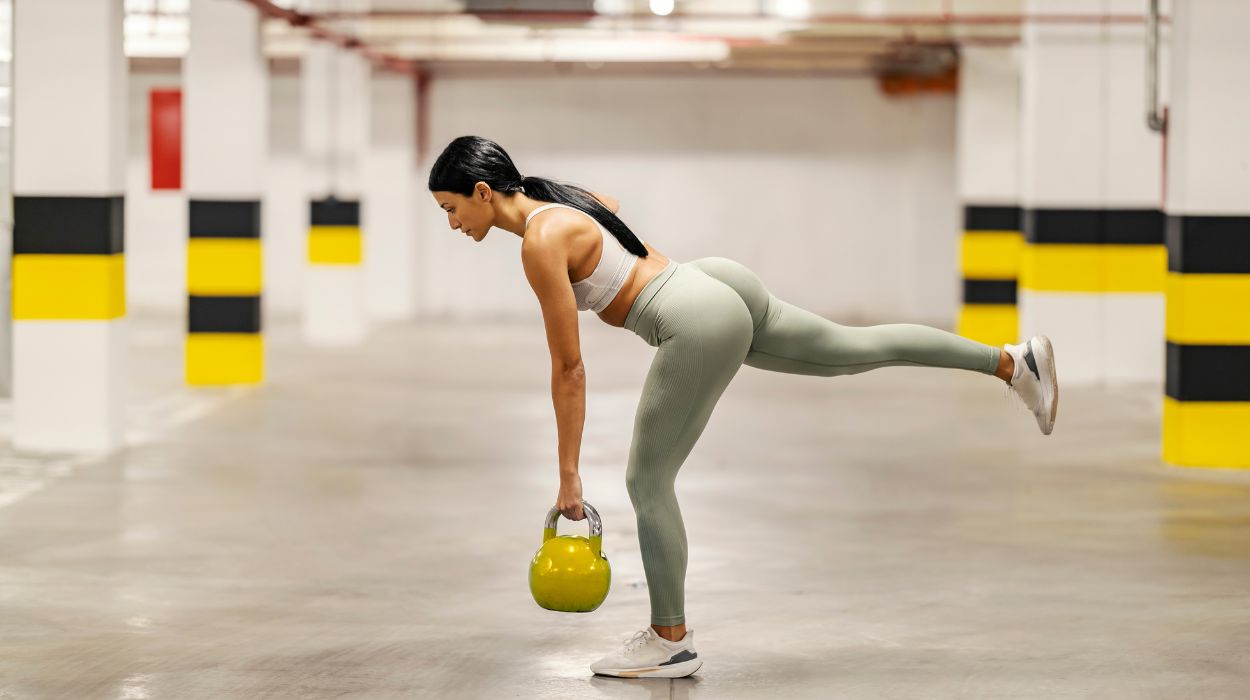
Full-Body Workout
Kettlebell exercises are well-known for their ability to engage multiple muscle groups simultaneously. This all-around effort increases your heart rate, making it an excellent calorie-burning workout.
Enhances Core Stability
Kettlebell core exercises involve lots of swinging and lifting, which requires balance. This promotes a stronger, more stable core, improving posture and body alignment.
Boosts Functional Strength
The natural movements in kettlebell training translate well into everyday life, improving your functional strength. It can help make daily tasks like lifting, bending, or pulling easier.
Promotes Cardiovascular Fitness
The dynamic nature of kettlebell exercises gets your heart pumping.[3] This cardio element can contribute to improved cardiovascular health.
Things To Consider When Practicing Kettlebell Ab Workout
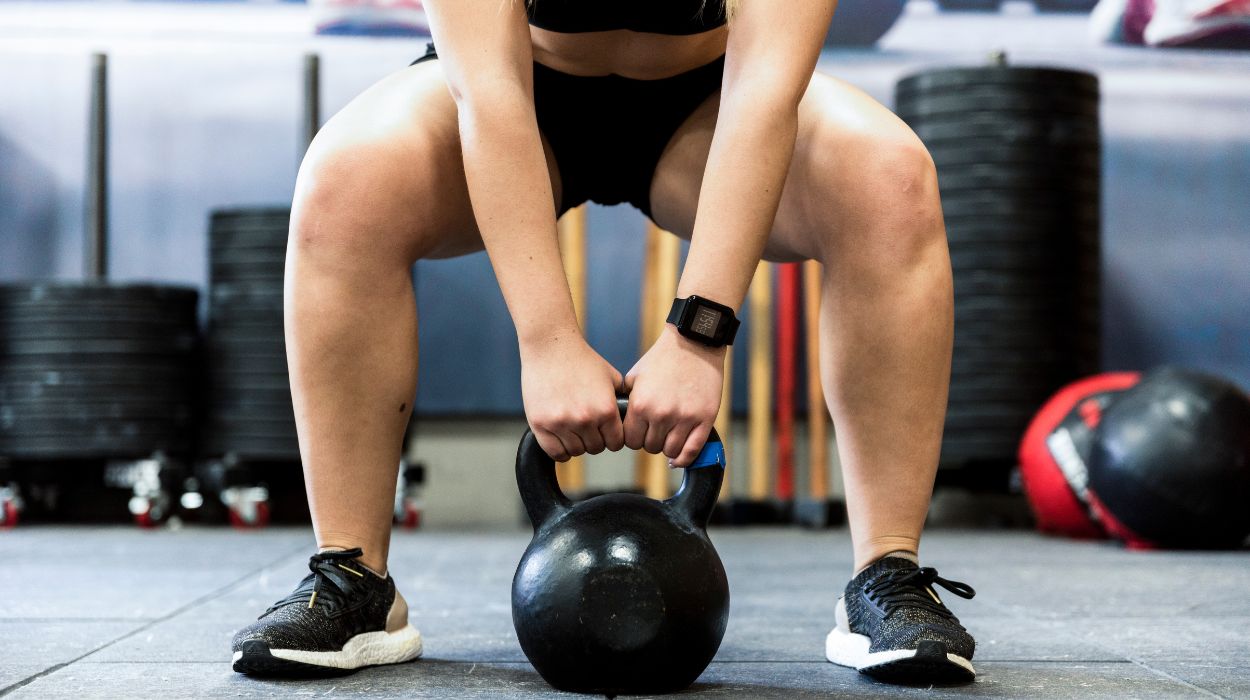
Just like any other fitness regime, a successful kettlebell workout plan requires some groundwork. Safety is always the most important factor to consider before taking your workouts to another level or introducing new techniques. Here are a few crucial factors to keep in mind.
Seek Professional Guidance
If you’re new to kettlebells, it’s wise to seek guidance from a fitness expert. They can teach you the correct form and technique, helping you avoid injuries and get the most out of your exercise regime.
Choose The Right Kettlebell
Kettlebells come in various weights. Select one that aligns with your current fitness level yet offers room for progression. As you get stronger, you can gradually move on to heavier kettlebells.
If you’re wondering about the best kettlebell where to buy, many fitness equipment stores and online marketplaces offer various options catering to all fitness levels.
Warm-Up And Cool-Down Are Crucial
A good warm-up prepares your body for the workout ahead, increasing blood flow and reducing the risk of injury. It improves your performance and allows you to get the most out of your kettlebell ab workout. A cool-down slowly returns your body to a steady metabolic state.
One key tip for any kettlebell exercise is to ensure proper alignment and balance, and, for example, that starts with your left leg planted firmly on the ground before you transition to the right.
Don’t Neglect Rest And Recovery
Rest is as important as the workout itself. Ensure you give your body ample time to recover after a challenging session. Rest days are essential for muscle repair and growth.
You don’t want to train the same muscle group two days in a row, so be sure to plan on having a rest day in between. You also want to get at least eight hours of sleep per night to promote proper recovery.
The Takeaways
Incorporating a kettlebell ab workout into your fitness routine is more than just a change – it’s an upgrade. It pushes your body, especially your core muscles, in ways that traditional workouts often fall short of. It’s an overall amazing choice of workout.
Why?
Incorporating a kettlebell ab workout into your fitness regime strengthens your core and improves your overall body strength and balance.
The dynamic movements involved in kettlebell training, such as the kettlebell swing or the kettlebell around the world, work your muscles from multiple angles. This results in a more comprehensive, well-rounded workout that can yield visible results sooner.
Moreover, pairing kettlebell workouts with a nutritious diet, appropriate rest, and helpful supplements can expedite your progress toward your fitness goals. A holistic approach always prevails; whether it’s weight loss or muscle gain, kettlebell exercises will help you achieve these goals.
So, strive for consistent workouts, maintain a balanced diet, and care for your body. With time and consistent effort, you’ll see positive changes, whether your goal is to lose weight or build muscle with the help of a specific vitamin regimen.
Frequently Asked Questions
Yes, kettlebell exercises work on your core muscles intensely.
You can develop abs with kettlebells with consistent training, a nutritious diet, and adequate rest. Remember, those abs only show through if you maintain a healthy weight.
While enthusiasm is admirable, giving your muscles time to rest is essential.
Performing ab workouts daily might lead to overtraining, hindering your progress. It’s usually recommended to perform ab workouts every other day for optimal results.
The definition of hardest varies depending on an individual’s fitness level.
However, in kettlebell ab exercises, the kettlebell Half-Get-Up is often considered challenging due to its complex movements and core strength requirements.
Absolutely. Planks are one of the most effective exercises for developing core strength. You can even try a plank variation using a kettlebell for added challenge and effectiveness.
Resources
- J. Asher Falatic, Plato, P.A., Holder, C.J., Finch, D., Han, K. and Cisar, C.J. (2015). Effects of Kettlebell Training on Aerobic Capacity. [online] 29(7), pp.1943–1947. doi:https://doi.org/10.1519/jsc.0000000000000845.
- Clark, J.H. (2015). Diet, exercise or diet with exercise: comparing the effectiveness of treatment options for weight-loss and changes in fitness for adults (18–65 years old) who are overfat, or obese; systematic review and meta-analysis. [online] 14(1). doi:https://doi.org/10.1186/s40200-015-0154-1.
- Budnar, R.G., Duplanty, A.A., Hill, D.J., McFarlin, B.K. and Vingren, J.L. (2014). The Acute Hormonal Response to the Kettlebell Swing Exercise. [online] 28(10), pp.2793–2800. doi:https://doi.org/10.1519/jsc.0000000000000474.




